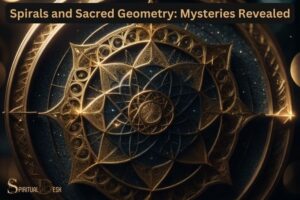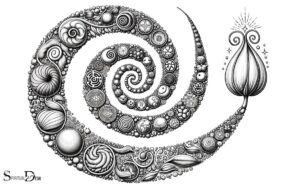Philosophical Spirals: Ancient Texts’ Insights
Philosophical spirals in ancient texts provide a deeper insight into the nature of existence, morality, reality, and knowledge. They offer valuable perspectives on human nature, societal structures, ethical dilemmas, and metaphysical questions.
Quick Overview
Delving into philosophical spirals in ancient texts opens up a treasure trove of wisdom that transcends time.
Whether it’s understanding Socratic questioning from Plato’s dialogues or contemplating impermanence through Buddhist sutras; these philosophical explorations offer timeless insights.
They challenge us to question our perceptions of reality while teaching us how to lead meaningful lives. Indeed, studying these ancient philosophical works broadens our worldview by providing different lenses to examine life’s complexities.

Origins Of Spirals In Ancient Philosophy
The concept of spirals has intrigued philosophers and thinkers throughout ancient history. The symbolic meaning behind spirals can be traced back to various ancient cultures, where they were often associated with profound philosophical ideas and spiritual beliefs.
Spiral Symbolism In Ancient Cultures
Ancient civilizations across the globe recognized profound symbolism in spirals. These enigmatic shapes were endowed with various meanings and interpretations, reflecting the beliefs and values of their respective cultures.
In Celtic culture, spirals were representative of a continuous journey of self-discovery and personal growth. The spiral shape was seen as a visual representation of the cyclical nature of life, the eternal process of transformation, and the interconnectedness of all beings.
In ancient Greece, spirals were associated with the concept of Logos, meaning divine reason or universal order.
The philosopher Heraclitus believed that everything in the cosmos is constantly changing and in flux, and the spiral became a symbol of this dynamic and ever-evolving nature of existence.
In Native American cultures, spirals were considered sacred symbols, representing the cycles of life, birth, death, and rebirth.
They were often depicted in petroglyphs and cave paintings, serving as powerful reminders of the interconnectedness of all living things and the continuity of the natural world.
Earliest References To Spirals In Philosophical Texts
As philosophical ideas developed and were documented in ancient texts, references to spirals began to emerge. One of the earliest known references can be found in Phaedrus by Plato, where he describes the consumption of the universe by a great whirling spiraling vortex.
Another influential philosophical work, The Confessions by Saint Augustine, references spirals as a metaphor for time and memory.
Augustine reflects on the spiraling nature of his own memories, where one thought leads to another, creating interconnected spirals that shape his understanding of the past and the present.
Early references to spirals in philosophical texts show their significance for ancient thinkers. Spirals were powerful symbols representing profound philosophical concepts and aiding in the exploration of existence’s mysteries.
Spirals In Ancient Greek Philosophy
Ancient Greek philosophy, known for its profound ideas, often features the spiral symbol, which holds significance for philosophers like Pythagoras, Plato, and Aristotle.
This article explores the presence and interpretation of spirals in Ancient Greek philosophy, revealing their hidden meanings.
Spiral Imagery In The Philosophy Of Pythagoras
Pythagoras saw the spiral as a symbol of the eternal cycle of life, growth, and transformation. He believed it represented the never-ending process of change and evolution, drawing inspiration from natural examples like seashells and flower petals.
These spirals reflected the divine order in the universe, revealing fundamental principles of existence.
In Pythagorean philosophy, the spiral also held a metaphorical meaning beyond its mathematical representation. It was perceived as a symbol of spiritual development, with the spiral’s inward progression signifying the journey towards self-realization and enlightenment.
Just as the spiral continuously narrows inwards, leading towards its center, Pythagoras believed that individuals should strive for inner growth, seeking to understand the deeper aspects of themselves and the universe.
Spirals As A Metaphor In Plato’s Philosophy
Plato used spirals metaphorically in his dialogues to illustrate concepts. In his allegory of the cave, the spiral symbolizes the philosopher’s journey toward higher knowledge, as they free themselves from sensory illusions and move towards the realm of pure Forms, progressing towards truth.
Additionally, Plato associated the spiral with the concept of dialectic, which he saw as the process of ascending towards ultimate wisdom. Similar to the spiral’s continuous and progressive nature, dialectic involves the systematic questioning and examination of ideas to attain deeper understanding.
The spiral serves as a reminder of the philosopher’s constant pursuit of knowledge, always spiraling upwards towards a higher level of insight and enlightenment.
Aristotle’s Interpretation Of Spirals In His Writings
Aristotle, the renowned philosopher and student of Plato, approached the concept of spirals from a scientific perspective.
In his work on natural philosophy, Aristotle analyzed the spiral form as it appeared in physical phenomena, such as the coiling patterns of certain plants and the shape of celestial bodies.
Aristotle believed the spiral embodied natural principles of motion and change. He noted spiral growth patterns in plants, attributing them to inherent growth principles.
Spirals In Ancient Eastern Philosophical Texts
Ancient Eastern philosophical texts are laden with rich symbolism and profound teachings, and one prevalent symbol that appears consistently is the spiral. This captivating geometric pattern can be found in various philosophical traditions, each carrying its own unique significance.
Spirals In The Taoist Philosophy Of Yin And Yang
The philosophy of Yin and Yang is rooted in the Taoist tradition, reflecting the interplay and balance between opposing forces. When we delve into the symbolism associated with Yin and Yang, we encounter a remarkable connection to spirals.
In Taoist philosophy, the symbol of Yin and Yang consists of two interlocking shapes, each containing a small dot of the opposite force. These shapes seamlessly blend into one another, forming a harmonious spiral-like pattern.
This spiral represents the perpetual cycle of change and transformation, emphasizing the dynamic nature of existence.
In Taoist philosophy, the spiral represents the cyclical process of growth and evolution, reflecting movement from darkness to light, chaos to order, contraction to expansion, and vice versa. Yin and Yang follow a similar spiral-like path, with each force paving the way for its opposite.
Spiral Patterns In Buddhist Teachings And Symbolism
Buddhism, an ancient spiritual tradition that emphasizes mindfulness and enlightenment, also incorporates the captivating symbolism of spirals.
In Buddhist art and sacred geometry, the spiral pattern can be observed in the form of seashell-like shapes known as “conch shells.” These shells are often depicted in Buddhist iconography, representing the emergence of enlightenment and the eternal path to awakening.
The spiral shape of the conch shell is said to symbolize the endless cycles of birth, death, and rebirth. It reminds practitioners of the impermanent nature of existence and the perpetual journey towards self-realization.
Moreover, the spiral is present in the labyrinth found in many Buddhist monasteries. This ancient symbol of spiritual pilgrimage represents the path inward, leading towards self-discovery and enlightenment.
As one walks along the winding path of the labyrinth, they are invited to reflect on their inner journey, transcending the constraints of the physical world.
The Spiritual Symbolism Of Spirals In Ancient Texts
Spirals As A Symbol Of Growth And Transformation In Ancient Spiritual Traditions
Ancient philosophical texts have long recognized the profound symbolism of spirals in spiritual traditions. The spiral shape, with its continuous and never-ending flow, has been associated with the concepts of growth, development, and transformation in various ancient cultures.
Celts, Egyptians, and Native Americans saw the spiral as symbolizing the natural cycles of life, including growth, decay, and rebirth. The spiral symbolized the path towards personal and spiritual evolution, signifying the continuous journey of self-discovery and enlightenment.
For these ancient cultures, the spiral represented the interconnectedness of all beings and the harmonious flow of universal energy. It was believed that embracing the spiral’s transformative power allowed individuals to navigate the challenges of life and reach higher levels of consciousness.
Connection Between Spirals And The Journey Of The Soul In Ancient Philosophies
Ancient philosophical texts highlighted the link between spirals and the soul’s eternal, cyclical journey through different realms.
Many ancient spiritual traditions believed in the concept of reincarnation, where the soul traverses multiple lifetimes to achieve spiritual growth and enlightenment. The spiral symbolizes this continuous journey, with each revolution representing a new phase of the soul’s evolution.
In ancient Greek philosophy, the spiral was associated with the concept of Anamnesis, the process of remembering one’s true nature and purpose.
According to Plato, the soul, imprisoned in the material world, must strive to recollect its divine origins through the spiral path of self-discovery and self-realization.
Ancient Egyptian texts portrayed the spiral as the route to the afterlife.The deceased would embark on a spiritual journey through a winding path, symbolized by the spiral, towards immortality and union with the divine.
Modern Interpretations Of Spirals In Ancient Philosophical Texts
Ancient philosophical texts have long fascinated scholars and seekers of wisdom, with their deep insights and profound symbolism. One recurring symbol that frequently appears in these texts is the spiral.
The spiral has been interpreted in various ways throughout history, and contemporary scholars continue to delve into its significance from a modern perspective.
Contemporary Scholars’ Analysis Of Spirals In Ancient Philosophy
Contemporary scholars have dedicated considerable time and effort to unravel the meanings behind spirals in ancient philosophical texts.
By examining these texts through a contemporary lens, they have shed new light on the philosophical and metaphysical implications of the spiral symbol.
One prominent interpretation is that spirals represent the cyclical nature of life, with each revolution symbolizing a new beginning or transformation. This interpretation aligns with the concept of eternal recurrence, which suggests that the universe repeats in an infinite cycle.
Relevance Of Spiral Symbolism In Modern Metaphysics And Spirituality
The symbolic power of spirals extends beyond ancient philosophy and continues to resonate with individuals in modern times. Spiritual traditions and metaphysical philosophies frequently incorporate spiral symbolism into their teachings and practices.
This is due to the belief that spirals are not just abstract symbols but embody the essence of existence itself.
For example, in many spiritual traditions, the spiral is associated with the concept of divine energy and cosmic consciousness. It is seen as a visual representation of the divine forces that permeate the universe and guide the unfolding of existence.
By contemplating spirals or incorporating them into meditation practices, individuals can tap into this universal energy, expand their consciousness, and deepen their spiritual connection.
Moreover, the relevance of spiral symbolism extends to modern psycho-spiritual theories and practices. Psychologists and therapists often use spiral imagery in healing modalities to facilitate personal transformation and healing.
The spiral represents the inward journey towards self-discovery, healing, and integration of the psyche. It serves as a powerful tool for individuals seeking to navigate through challenges, release old patterns, and embrace new ways of being.
The Mathematical And Geometrical Significance Of Spirals In Ancient Thought
Spirals have fascinated ancient philosophers across different civilizations. They recognized the mathematical and geometrical significance of spirals, which were often incorporated into their philosophical texts, architectural designs, and artistic expressions.
We explore two key aspects of spirals in ancient thought: the Golden Ratio and Fibonacci sequence in ancient mathematical understanding of spirals, and spiral geometry in ancient architecture and design principles.
The Golden Ratio And Fibonacci Sequence In Ancient Mathematical Understanding Of Spirals
Ancient mathematicians were captivated by the inherent harmony and beauty found in the spiral shape. They discovered a mathematical relationship called the Golden Ratio that governed the growth and proportions of spirals in nature and art.
This special ratio, approximately 1.618, is found by dividing a line into two parts such that the ratio of the whole line to the longer segment is equal to the ratio of the longer segment to the shorter segment.
Additionally, another fascinating mathematical sequence called the Fibonacci sequence ties into the growth pattern of spirals.
The Fibonacci sequence starts with 0 and 1, with each subsequent number being the sum of the previous two numbers. As the sequence progresses, dividing consecutive numbers approximates the Golden Ratio.
Both these mathematical concepts demonstrate the interplay between spirals, proportionality, and harmonious growth.
Spiral Geometry In Ancient Architecture And Design Principles
Ancient architects and designers recognized the aesthetic and structural power of spirals. They incorporated spiral geometry into their creations, like the Hypostyle Hall in the Karnak Temple complex in ancient Egypt or in the awe-inspiring Parthenon in ancient Greece.
By integrating spirals into their architectural designs, craftsmen and architects sought to establish a visual and symbolic connection with the cosmic order and the harmonious rhythm of the universe.
Spiraling motifs in columns and friezes not only added a sense of dynamism and fluidity but also emphasized concepts of eternity, rebirth, and spiritual transcendence.
Moreover, the application of spiral geometry extended beyond monumental structures. Ancient artists imbued their compositions with spirals, as seen in intricate mosaics, wall paintings, and pottery designs. This widespread use of spiral aesthetics underscores its prominence in ancient thought.
Conclusion
To sum up, spirals hold a significant place in ancient philosophical texts, representing the interconnectedness of life and the perpetual cycle of change. These elegant patterns, found in various aspects of nature and human existence, have fascinated philosophers throughout history.
Delving into these texts provides valuable insights into the deeper meaning and symbolism of spirals, shedding light on the timeless wisdom of our ancestors.
Exploring these ancient philosophies encourages us to embrace the beauty and complexities of the world around us, reminding us of the intricate harmony that exists within the universe.






